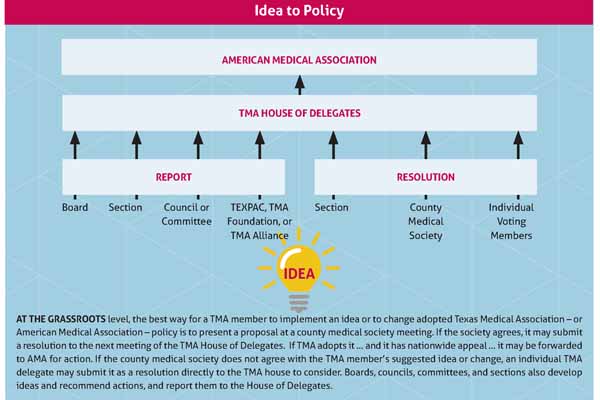
Texas is a national leader in medicine by virtue of the fact that the Texas Medical Association is the country’s largest state medical society, with more than 56,000 members.
But TMA’s impact on the national stage hinges in part on the activism of roughly three dozen TMA members who serve as representatives (delegates and alternate delegates) to the American Medical Association House of Delegates, the principal policymaking body of AMA.
“Like it or not, the AMA is the voice of physicians at the national level,” said San Antonio pathologist David Henkes, MD, chair of the Texas Delegation to the AMA. “There’s just no one else.”
Physicians frequently see national policies and procedures that need to change, and they have several options for being heard, says San Antonio radiologist Zeke Silva, MD, an alternate AMA delegate. Like everyone else, they can lobby a member of Congress, go to the press, or contact any private entities involved.
But Texas physicians amplify their voices when they join county medical societies and TMA in part because they can then elect delegates and alternate delegates who speak for them at the AMA house, he says. Their input can influence national legislation, agency rules, industry guidelines, and medical best practices.
“We elect representatives whom we trust and who are vetted to allow them to translate our needs and our policy concerns into decision-making,” said Dr. Silva. He chairs AMA’s Relative Value Scale Update Committee, which assesses the impact of science and technology on patient care and convenes expert physician input that informs Medicare payment policy.
Texas has enjoyed strong representation in AMA leadership in recent years. Among other Texas physicians, Fort Worth allergist and immunologist Susan R. Bailey, MD, served as AMA president in 2021-22; Houston facial plastic and reconstructive surgeon Russ Kridel, MD, chaired the AMA Board of Trustees; and incoming TMA President Gary Floyd, MD, a Fort Worth pediatrician, served on AMA’s Council on Legislation. (See “Natural-Born Healer,” page 18.)
“Having Texans in leadership positions helps give a Texas perspective,” Dr. Bailey said. And unless Texas cultivates its AMA membership growth, it risks having its voice diminished.
“The AMA is the organization that legislators and regulators and – from my experience personally, the media – turn to for policy and for trusted medical advice,” she said. “The more Texas physicians we have involved in the AMA House of Delegates, the more Texans will be able to influence AMA policy.”

The AMA House of Delegates is composed of more than 600 voting delegates and an equal number of alternate delegates. Though separate, independent entities from AMA, state medical societies help select AMA delegates. So do national specialty societies, branches of the U.S. military, and 11 AMA sections (tma.tips/AMA-HOD).
“The AMA House of Delegates has almost 200 organizations represented in it from every state, every specialty society,” Dr. Bailey said. “It’s an incredibly diverse group.”
Texas, the nation’s second-most populous state after California, should be more influential in the AMA house, Dr. Henkes says. But AMA bases its delegate count from each state on AMA membership from each state.
While TMA has 56,000 members, only about 20,000 Texas physicians belong to AMA, he says.
Meanwhile, other states have carefully built the size of their delegations by increasing AMA memberships in recent years, Dr. Henkes says. For instance, California’s delegation was about the same size as Texas’ until recently. The state has significantly boosted its AMA membership with encouragement from a major health care company and now has 38 delegates and 33 alternate delegates.
By comparison, TMA has 20 delegates and 13 alternate delegates.
But it’s often hard to tell the two positions apart, Dr. Silva says. Alternate delegates don’t just fill in when a delegate cannot vote. They are used more like substitutes off the bench in basketball – an integral part of the team and the action.
As chair of the Texas delegation, Dr. Henkes is the “coach” who decides who plays, and said, “It’s hard for me to even tell you who’s a delegate and who’s an alternate delegate because we treat them pretty much the same. Having 20 delegates means we have 20 votes in the house. But frequently delegates will give their voting positions to alternates so they can take part and vote.”
AMA’s procedure for creating policy is very similar to TMA’s, “just at a much bigger level,” explained Fort Worth obstetrician-gynecologist Shanna Combs, MD, an alternate delegate. Physicians propose and vote on resolutions before the house after those proposals have been discussed and shaped by reference committees. Physicians who have worked to pass resolutions in the TMA House of Delegates will feel right at home, she says.
AMA’s House of Delegates meets twice a year in June and November for about five days, and the time commitment during those days – and leading up to them – is intense, Dr. Silva acknowledges. TMA’s delegates meet to strategize when TMA meets at the annual TexMed conference and at the fall and winter conferences.
“I’ve never tried to quantify [the time commitment], but those who find it meaningful and worthwhile, we don’t look at it as work,” he said. “It’s an opportunity.”
The Texas delegation routinely shapes important resolutions before the AMA House of Delegates, ranging from strengthening public health and improving support for rural physicians, to fighting off cuts to Medicare physician payments.
But TMA and AMA have not seen eye to eye on some important medical issues, such as Congress’ approval of the Affordable Care Act (ACA) in 2009-10. AMA supported the law, and TMA adopted a more nuanced “fix what’s broken, keep what’s good” policy.
Texas voices within AMA have since tempered full-throated support for the law, Dr. Bailey says.
“Even though the AMA supported the Affordable Care Act, I think it was the strong influence of Texas physicians, along with many others, that helped the organization understand that opinions about the ACA were divided and that there were many physicians in the country who did not think it was the right thing to do at the time,” she said.
AMA – like TMA – is a big, diverse group, and no physician should count on agreeing with AMA 100% of the time, Dr. Combs says. Instead, Texas physicians should join and work with fellow TMA members to help physicians in other states understand our state’s perspective.
“The AMA over time has made some good decisions and some bad decisions, but ultimately it’s led by its members,” she said.
There’s no one best way to get involved with AMA or its House of Delegates, Dr. Silva says.
“The best on-ramp really depends on where you are in your career,” he said.
Medical students, residents, and younger physicians may be able to get involved through one of AMA’s 11 member sections. Each section sends delegates to the AMA house.
More established physicians can work through their specialty societies, Dr. Silva says. And of course, all TMA members can get started by working through their county medical societies and through TMA councils and committees. (See “TMA Councils and Committees” and “TMA Leadership College.")
“I really like the county medical societies as a great way of getting introduced to policymaking,” he said.
Physicians also are welcome to talk to current AMA delegates and even to share their thoughts at delegation meetings, Dr. Henkes says.
Tex Med. 2022;118(3):33-37
April 2022 Texas Medicine Contents
Texas Medicine Main Page